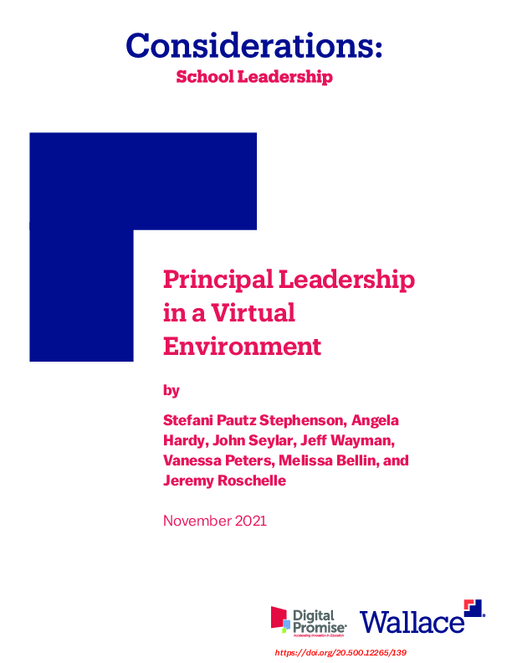- Author(s)
- Stefani Pautz Stephenson, Angela Hardy , John Seylar, Jeff Wayman, Vanessa Peters, Melissa Bellin , and Jeremy Roschell
- Publisher(s)
- Digital Promise
- DOI Link
- https://doi.org/20.500.12265/139
Research Approach
Digital Promise developed the recommendations in this report through a research review and interviews. First, authors reviewed existing research on the intersections of school leadership, virtual learning, equity, and the seven parts of an effective principal pipeline. Second, in early 2021 they conducted interviews with 11 leaders from five school districts. These districts had been recognized by Digital Promise for sustaining powerful teaching and learning in the shift to virtual learning during the COVID-19 pandemic.
The research review began with relevant publications from the RAND Corporation and Policy Studies Associates, namely “Laying the Foundation for Successful School Leadership,” by Burkhauser et al., and the “Building a Stronger Principalship” series by Turnbull et al. These publications were chosen first because of their positioning at the intersection of principal leadership and equity. By reviewing the works cited in these documents, as well as subsequent publications that cited them, the authors began their search in databases such as EBSCO, ERIC and JSTOR. Key terms included the names of each of the seven domains, “equity,” “equitable,” “remote learning,” “virtual learning,” “principal,” “leadership,” and other terms specific to each domain. They prioritized recent scholarship (publications published within the past five years) as well as peer-reviewed scholarship.
Relevant publications were cataloged and tagged with the publication’s relevance to any of the seven domains. Through this, three key questions began to emerge. The search then broadened to include white papers, technical reports, and other emerging sources that while non-academic, were timely, relevant, and trusted. This phase of the literature review continued through drafting and helped inform the interview process that took place in spring 2021 by identifying gaps in the evidence base and areas for further research.
To begin to addressing these gaps, the research team selected and interviewed eight principals and three district administrators from five districts total. They recruited all participants from districts that had been recognized by Digital Promise for sustaining powerful teaching and learning during the shift to virtual learning, drawing from Digital Promise’s League of Innovative Schools (a national network of forward-thinking leaders in education aiming to design, validate, champion, and scale effective, innovative learning opportunities to advance equity and excellence for every student), and the organization’s Education Leadership Institute networks (a cohort of district and school leaders who worked together as thought partners on planning and implementation, problem-solving strategies, and practical resources to meet the urgent education and equity challenges impacting their school communities during the COVID-19 pandemic).
In selecting these 11 individuals, the authors considered diversity in their sample in terms of participant race/ethnicity (30 percent of interviewees are BIPOC), participant years of experience, district size, urban-rural classification, student demographics, and geographic region. Where possible, they interviewed up to three leaders within the same school district to capture multiple perspectives of participant experiences within the same system.
Interviews were conducted between February and March 2021.
The authors acknowledge that there are limitations to their research and recommendations. In their review of the literature, they found that while there is ample research in some areas, such as school leadership and equity of access, there is little research on principals leading in a virtual environment. Further, while they seldom, if ever, found scholarship with overlap across the topics of leadership, equity, and virtual learning environments, the authors were able to find scholarship with at least some overlap in two areas. For instance, many publications addressed responsible, equitable school leadership but did not do so in a virtual learning context. Other studies showed how school leaders can enable meaningful use of technology but did not discuss equity considerations. In this report, the authors are bringing together what is known and applying it to a new area not explicitly in the research—high-quality, equitable virtual learning and comprehensive, aligned pipelines. Therefore, they consider this report an early effort at insights, based on Digital Promise’s practical experiences in the field, interviews with a modest number of technology-adept principals and administrators, and an emerging, but small, research base.

